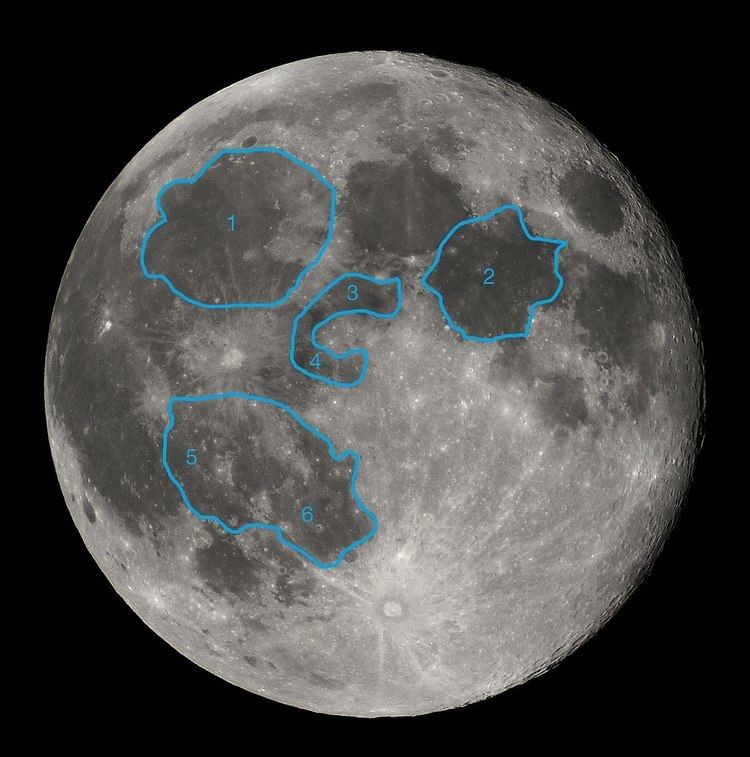 | ||
The Man in the Moon refers to any of several pareidolic images of a human face, head or body that certain traditions recognise in the disc of the full moon. The images are composed of the dark areas of the lunar maria, or "seas" and the lighter highlands of the lunar surface.
Contents
Examples and occurrence globally
One older European tradition sees a figure of a man carrying a wide burden on his back. He is sometimes seen as accompanied by a small dog. Various cultures recognise other examples of lunar pareidolia, such as the Moon rabbit.
In the Northern Hemisphere, a common Western perception of the face has it that the figure's eyes are Mare Imbrium and Mare Serenitatis, its nose is Sinus Aestuum, and its open mouth is Mare Nubium and Mare Cognitum. This particular human face can also be seen in tropical regions on both sides of the equator. However, the moon orientation associated with the face is observed less frequently—and eventually not at all—as one moves towards the South Pole.
Conventionalized illustrations of the Man in the Moon seen in Western art often show a very simple face in the full moon, or a human profile in the crescent moon, corresponding to no actual markings.
"The Man in the Moon" can also refer to a mythological character said to live on or in the moon, but who is not necessarily represented by the markings on the face of the moon. An example is Yue-Laou, from Chinese tradition.
Origin stories
There are various explanations for how the Man in the Moon came to be.
A longstanding European tradition holds that the man was banished to the moon for some crime. Christian lore commonly held that he is the man caught gathering sticks on the Sabbath and sentenced by God to death by stoning in the book of Numbers XV.32-36. Some Germanic cultures thought he was a man caught stealing from a neighbor's hedgerow to repair his own. There is a Roman legend that he is a sheep-thief.
One medieval Christian tradition claims him as Cain, the Wanderer, forever doomed to circle the Earth. Dante's Inferno alludes to this:
This is mentioned again in his Paradise:
There is also a Talmudic tradition that the image of Jacob is engraved on the moon, although no such mention appears in the Torah.
John Lyly says in the prologue to his Endymion (1591), "There liveth none under the sunne, that knows what to make of the man in the moone."
In Norse mythology, Máni is the male personification of the moon who crosses the sky in a horse-drawn carriage. He is continually pursued by the Great Wolf Hati who catches him at Ragnarök. The name Máni simply means "Moon".
In Chinese mythology, the goddess Chang'e is stranded upon the moon after foolishly consuming a double dose of an immortality potion. She is accompanied by a small group of moon rabbits.
In Haida mythology, the figure represents a boy gathering sticks. The boy's father had told him the moon's light would brighten the night, allowing the chore to be completed. Not wanting to gather sticks, the boy complained and ridiculed the moon. As punishment for his disrespect, the boy was taken from earth and trapped on the moon.
Traditions
There is a traditional belief that the Man in the Moon enjoyed drinking, especially claret. An old ballad runs (original spelling):
In the English Middle Ages and renaissance, the moon was held to be the god of drunkards, and at least three London taverns were named "The Man in the Moone". The man in the moon is named in an early dated English nursery rhyme:
Scientific explanation
The Man in the Moon is made up of various lunar maria (which ones depends on the pareidolic image seen). These vast, flat spots on the moon are called "maria" or "seas" because, for a long time, astronomers believed they were large bodies of water. They are large areas formed by lava that covered up old craters and then cooled, becoming smooth, basalt rock.
The near side of the moon, containing these maria that make up the man, is always facing earth. This is due to a tidal locking or synchronous orbit. Thought to have occurred because of the gravitational forces partially caused by the moon's oblong shape, its rotation has slowed to the point where it rotates exactly once on each trip around the earth. This causes the near side of the moon to always turn its face toward earth.
